1.Docker network
docker's network function is still relatively weak.
After docker is installed, three types of networks will be created automatically: bridge, host and none
1.1 bridging network
Premise:
Stop the docker compose warehouse in front
docker-compose stop
Install bridge network
yum install bridge-utils -y
brctl show

docker run -d --name demo nginx
The docker inspect demo view information ip is 0.2
 docker run -it --rm busybox
docker run -it --rm busybox
ip addr ##ip is 0.3

1.2.host network mode
docker run -d --name demo --network host nginx
Looking at the port, you can find that the image nginx running docker occupies port 80
 Parameter - network host will occupy port 80 of the virtual machine. Other nginx will not use port 80
Parameter - network host will occupy port 80 of the virtual machine. Other nginx will not use port 80
1.3.none mode
docker run -it --rm --network none busybox
 Only lo interface
Only lo interface
2. Custom network
2.1. Create a custom bridge
It is recommended to use a custom network to control which containers can communicate with each other. You can also automatically DNS resolve container names to IP addresses.
Create a bridge. The view type is bridge
docker network create mynet1 (Create bridge by default)or docker network create -d bridge mynet1 docker network ls

Test:
docker run -d --name demo1 --network mynet1 nginx
docker run -it --rm --network mynet1 busybox


ping demo1
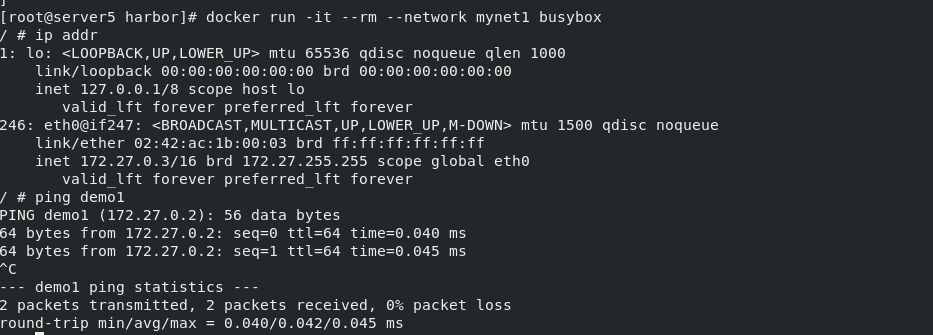
Yes, the ping demo can be directly successful, indicating that this mode can provide parsing for
In addition, the system will automatically allocate ip, and the ip will increase monotonically according to the startup order, but the address will be resolved automatically when ping ing the name
2.2. User defined network segment
docker network rm mynet1 docker network create -d bridge --subnet 10.0.0.0/24 --gateway 10.0.0.1 mynet1
docker inspect mynet1 ## view information
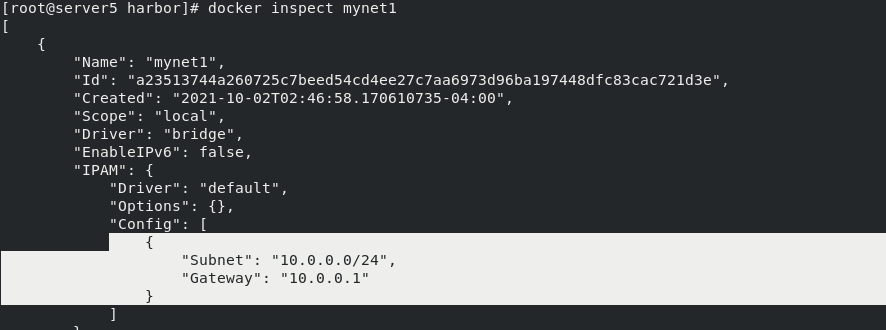
2.3. Specify ip manually
Use the – ip parameter to specify the container ip address, but it must be on a custom bridge
docker run -d --name web1 --network mynet1 nginx
docker run -it --rm --network mynet1 busybox
/ # ip addr
254: eth0@if255: <BROADCAST,MULTICAST,UP,LOWER_UP,M-DOWN> mtu 1500 qdisc noqueue
link/ether 02:42:0a:00:00:03 brd ff:ff:ff:ff:ff:ff
inet 10.0.0.3/24 brd 10.0.0.255 scope global eth0
valid_lft forever preferred_lft forever
/ # ping web1 PING 10.0.0.1 (10.0.0.2): 56 data bytes 64 bytes from 10.0.0.2: seq=0 ttl=64 time=0.043 ms 64 bytes from 10.0.0.2: seq=1 ttl=64 time=0.042 ms --- 10.0.0.1 ping statistics --- 2 packets transmitted, 2 packets received, 0% packet loss round-trip min/avg/max = 0.042/0.042/0.043 ms
cat /etc/hosts
 Automatic parsing
Automatic parsing
You can also ping the gateway
2.4. Dual network cards to realize communication between different network segments
Containers bridged to different bridges do not communicate with each other.
docker network create -d bridge --subnet 20.0.0.0/24 --gateway 20.0.0.1 mynet2
docker run -it --rm --network mynet2 busybox
 ping failed
ping failed
docker ps docker network connect mynet1 elastic_ After Brahmagupta
docker network connect mynet1 elastic_ After Brahmagupta
ping web1/web2
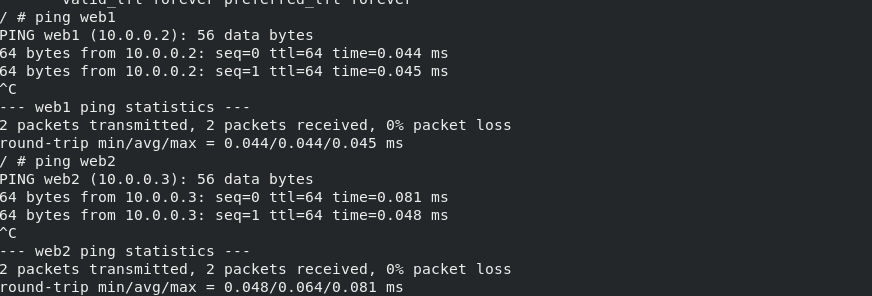 success
success
The principle is to add 10.0.0 ip in busybox

3.Docker container communication
In addition to ip communication, containers can also communicate by container name.
dns resolution must be used in custom networks.
Use – network container:web1 to specify when creating a container.
docker run -it --rm --network container:web1 busyboxplus
The Docker container in this mode will share a network stack, so that the two containers can communicate efficiently and quickly using localhost.
curl localhost
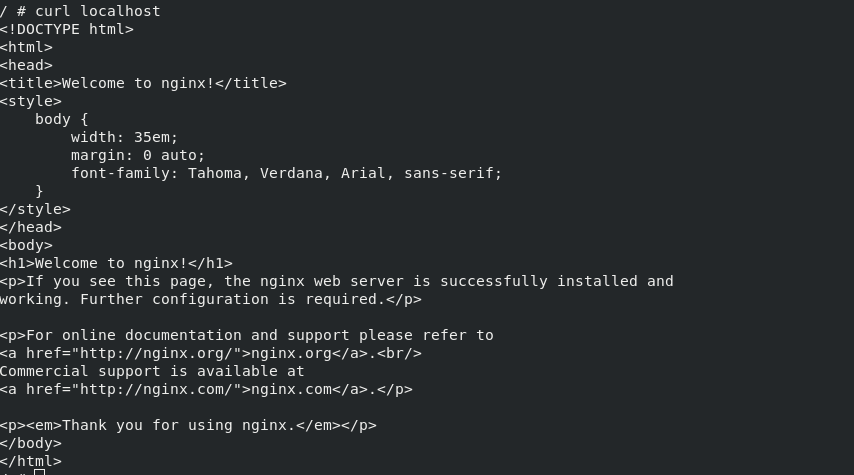
– link can be used to link 2 containers.
– link format:
–link **:alias
Name is the name of the source container, and alias is the alias of the source container under link.
docker run -d --name web1 nginx docker run -it --rm --link web1:nginx busyboxplus
ping web1
 cat /etc/hosts
cat /etc/hosts

env
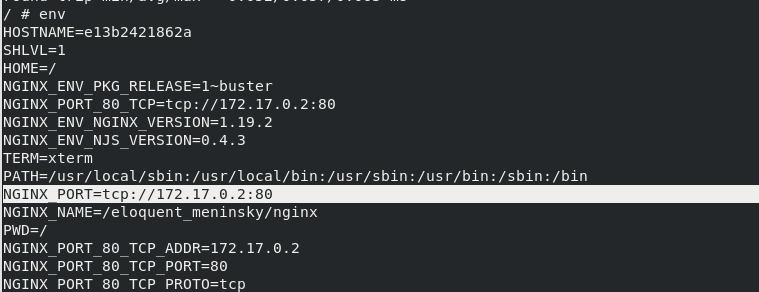
Open a terminal link server5 again
docker stop web1 docker run -d --name web2 nginx docker start web1
We ping again and find that the IP has changed (from 172.17.02 > > 172.17.0.4), but we can still ping the name web1 or nginx successfully, indicating that its i name changes with the real-time update of the IP
At this time, we check / etc/hosts and have automatically modified the parsing for us
127.0.0.1 localhost ::1 localhost ip6-localhost ip6-loopback fe00::0 ip6-localnet ff00::0 ip6-mcastprefix ff02::1 ip6-allnodes ff02::2 ip6-allrouters 172.17.0.4 nginx cc04bfdcf946 web1 172.17.0.3 01239d8f8819
3.1. Internal access external
The inside of the container can also access the external network
sysctl -a | grep ip_forward
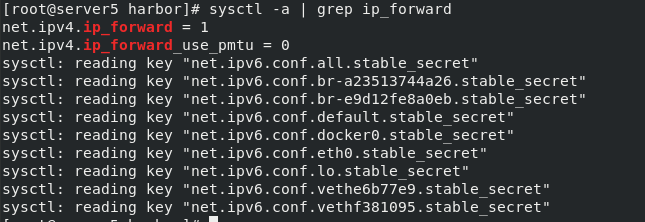 We can ping baidu.com in the container
We can ping baidu.com in the container
docker run -it --rm --link web1:nginx busybox ping baidu.com

3.2. External access internal
How the container accesses the Internet is realized through the SNAT of iptables
Internet access container
Port mapping
-The p option specifies the mapping port
Delete the previous container first
docker run -d --name web1 -p 80:80 nginx
iptables -t nat -nL
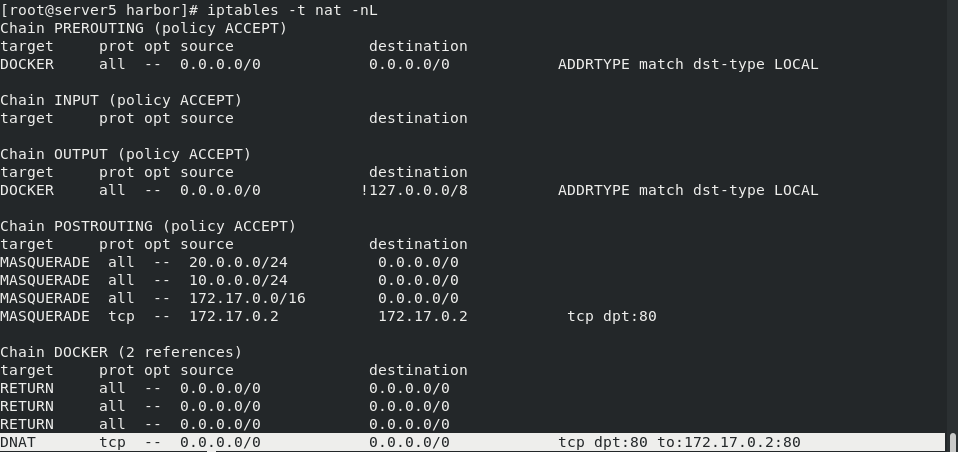 netstat -antlp found docker proxy
netstat -antlp found docker proxy

3.2.1 principle
Docker proxy and iptables DNAT are used in the external network access container
The host accesses the native container using iptables DNAT
External hosts access containers or access between containers is a docker proxy implementation
Test:
curl 172.25.76.5
curl localhost
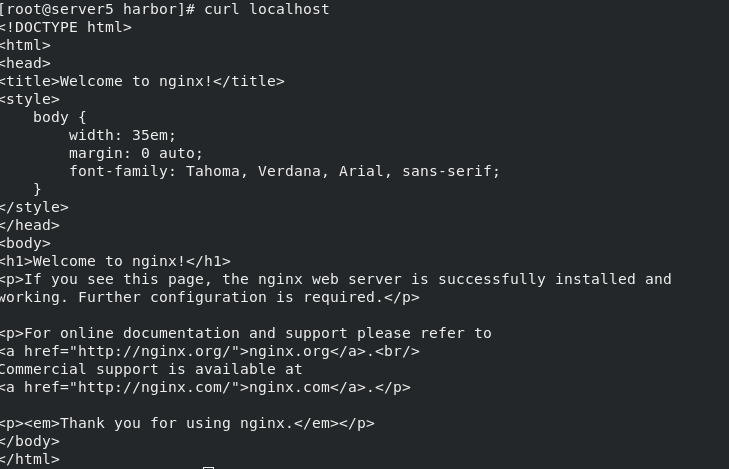
Now try to delete the policy in iptables and test again
iptables -t nat -F iptables -t nat -nL
 curl localhost
curl localhost
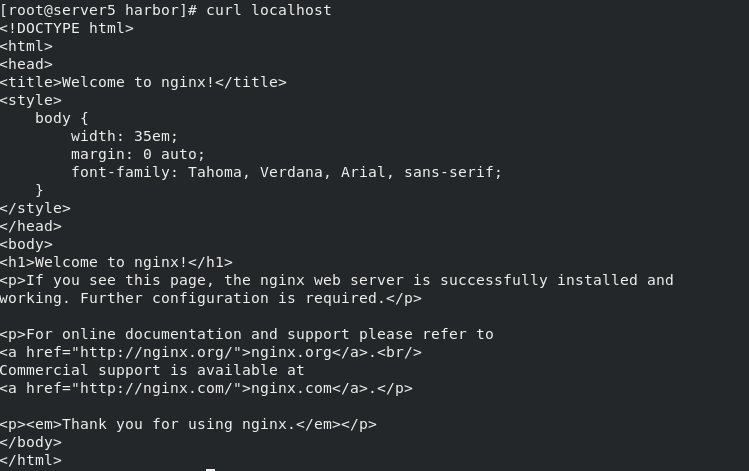 Because the docker proxy is still there
Because the docker proxy is still there
If you kill the docker proxy process, it's gone
 kill -9 28716 28721
kill -9 28716 28721
Visit again
 When we reopen docker
When we reopen docker
iptables will be regenerated
systemctl restart docker iptables -t nat -I POSTROUTING -s 172.17.0.0/16 -j MASQUERADE
`curl 172.25.76.5
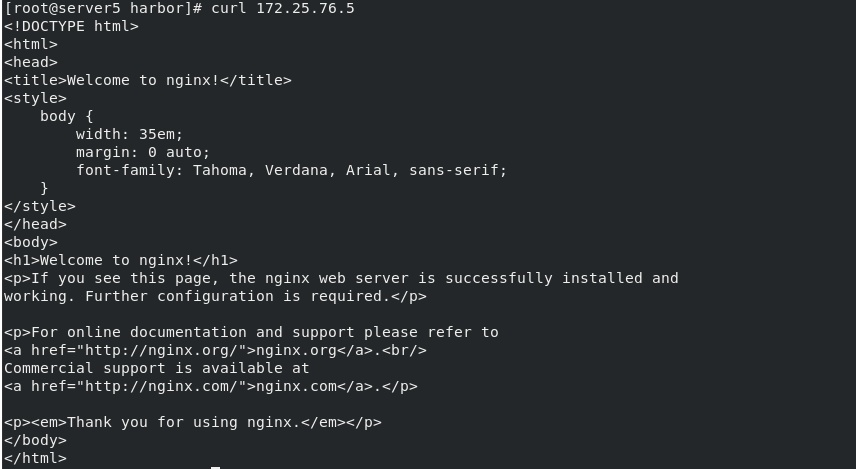
You can also access the release page of nginx
The results show that:
There must be at least one policy in docker proxy and iptables
4. Create MAC VLAN network
Construction of experimental environment:
Server5 (original virtual machine):
cat /etc/yum.repos.d/dvd.repo
[dvd] name=rhel7.6 baseurl=http://172.25.76.250/rhel7.6 gpgcheck=0 [docker] name=docker-ce baseurl=http://172.25.76.250/20 gpgcheck=0
scp /etc/yum.repos.d/dvd.repo root@172.25.76.4:/etc/yum.repos.d/ scp /etc/sysctl.d/docker.conf server4:/etc/sysctl.d/
server4:
Yum install docker ce - y
systemctl enable --now docker
The steps of installing docker are omitted. Please read the previous blog
Plus busyboxplus
docker pull radial/busyboxplus
docker tag radial/busyboxplus:latest busyboxplus:latest
docker rmi radial/busyboxplus:latest
4.1. Use eth1 network card to communicate
Server 4 (5): all need to do the same
Add a network card
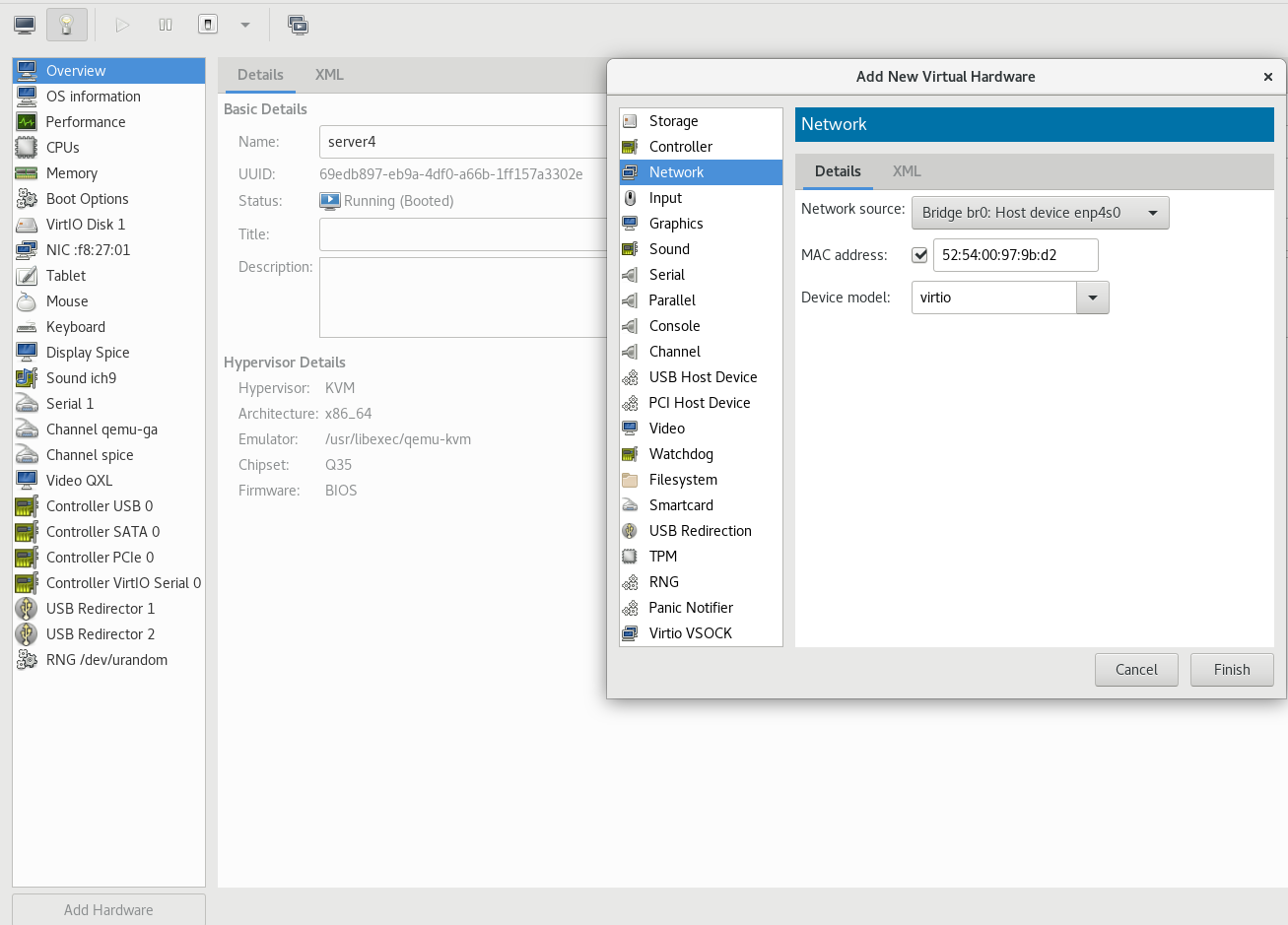
ip addr show eth1 #View ip
 cp /etc/sysconfig/network-scripts/ifcfg-eth0 /etc/sysconfig/network-scripts/ifcfg-eth1
cp /etc/sysconfig/network-scripts/ifcfg-eth0 /etc/sysconfig/network-scripts/ifcfg-eth1
vim /etc/sysconfig/network-scripts/ifcfg-eth1
BOOTPROTO=none ONBOOT=yes DEVICE=eth1
ip link set eth1 promisc on
ifup eth1
It is found that the promise mode appears in eth1 of ip addr
server5:
Delete the network bridge of the previous experiment
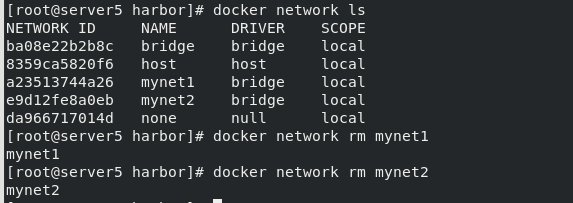
Create a container with specified conditions on server5, and then run the container:
docker network create -d macvlan --subnet 10.0.0.0/24 --gateway=10.0.0.1 -o parent=eth1 macvlan1 docker run -it --rm --network macvlan1 --ip 10.0.0.10 busyboxplus ip addr
 On server4:
On server4:
Create a container and run the same operation as server5 (only the IP is inconsistent!)!
docker network create -d macvlan --subnet 10.0.0.0/24 --gateway=10.0.0.1 -o parent=eth1 macvlan1 docker run -it --rm --network macvlan1 --ip 10.0.0.11 busyboxplus ip addr
 Test:
Test:
ping the ip address of the docker of server4 on the docker of server5:
server5:
docker run -d --name web1 --network macvlan1 --ip 10.0.0.10 nginx
server4:
docker run -it --rm --network macvlan1 --ip 10.0.0.11 busyboxplus
ping 10.0.0.10
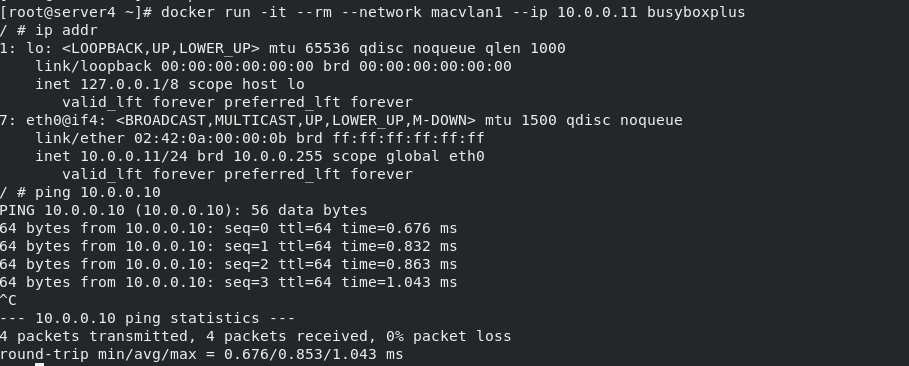 curl 10.0.0.10
curl 10.0.0.10
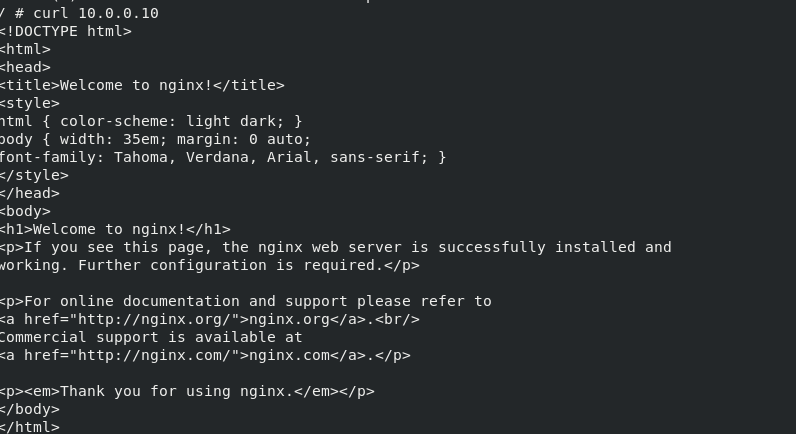 success
success
Virtual VLAN network card can also be used for experiments:
On server4 and server5:
docker network create -d macvlan --subnet 20.0.0.0/24 --gateway 20.0.0.1 -o parent=eth1.1 macvlan2 ip addr
 Create a container with ip 20.0.0.10 on server5 and 20.0.0.11 on server4
Create a container with ip 20.0.0.10 on server5 and 20.0.0.11 on server4
[root@server5 ~]# docker run -it --rm --network macvlan2 --ip 20.0.0.10 busyboxplus [root@server4 ~]# docker run -it --rm --network macvlan2 --ip 20.0.0.11 busyboxplus
ipaddr
View ip
server5:
 server4:
server4:
ping 20.0.0.10
 success
success
conclusion
The IP of different network segments cannot be interconnected, but two containers in different network segments can generate the same network segment IP address by docker network connect macvlan1 to realize the communication between containers.
About virtual VLAN cards:
Virtual VLAN network cards are not actual network interface devices, and can also appear in the system as network interfaces. However, they do not have their own configuration files, but only VLAN virtual network cards generated by adding physical networks to different VLANs. Their network interface names are eth0.1 and eth1.1.
Note: when VLAN virtual network card needs to be enabled, there must be no IP address configuration information on the network interface of the associated physical network card, and the subnet cards of these primary physical network cards must not be enabled and must not have IP address configuration information.